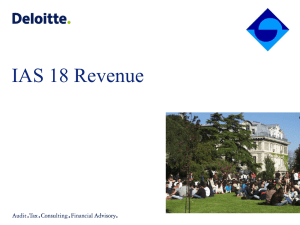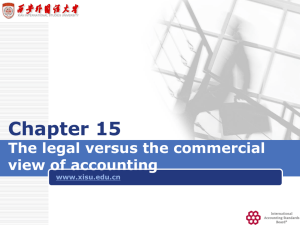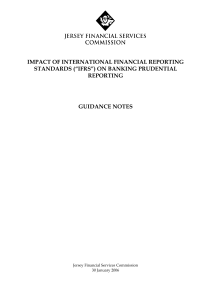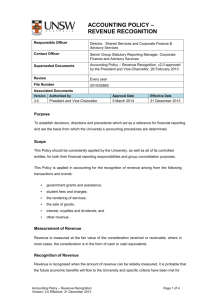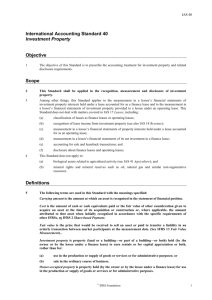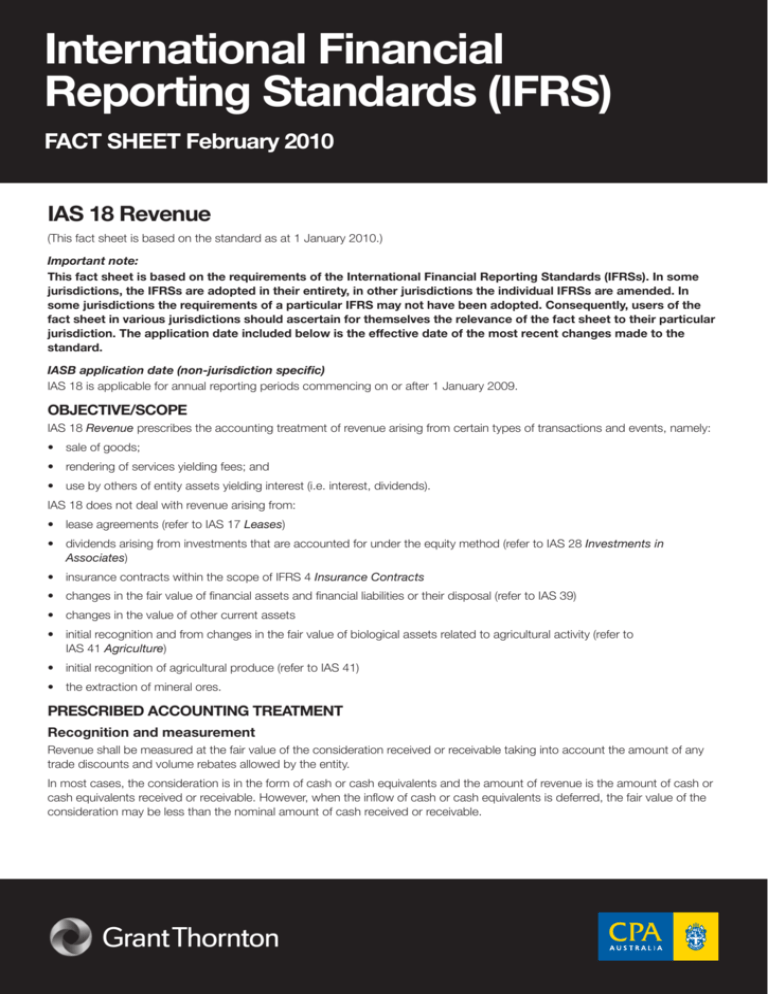
International Financial
Reporting Standards (IFRS)
FACT SHEET February 2010
IAS 18 Revenue
(This fact sheet is based on the standard as at 1 January 2010.)
Important note:
This fact sheet is based on the requirements of the International Financial Reporting Standards (IFRSs). In some
jurisdictions, the IFRSs are adopted in their entirety, in other jurisdictions the individual IFRSs are amended. In
some jurisdictions the requirements of a particular IFRS may not have been adopted. Consequently, users of the
fact sheet in various jurisdictions should ascertain for themselves the relevance of the fact sheet to their particular
jurisdiction. The application date included below is the effective date of the most recent changes made to the
standard.
IASB application date (non-jurisdiction specific)
IAS 18 is applicable for annual reporting periods commencing on or after 1 January 2009.
Objective/scope
IAS 18 Revenue prescribes the accounting treatment of revenue arising from certain types of transactions and events, namely:
• sale of goods;
• rendering of services yielding fees; and
• use by others of entity assets yielding interest (i.e. interest, dividends).
IAS 18 does not deal with revenue arising from:
• lease agreements (refer to IAS 17 Leases)
• dividends arising from investments that are accounted for under the equity method (refer to IAS 28 Investments in
Associates)
• insurance contracts within the scope of IFRS 4 Insurance Contracts
• changes in the fair value of financial assets and financial liabilities or their disposal (refer to IAS 39)
• changes in the value of other current assets
• initial recognition and from changes in the fair value of biological assets related to agricultural activity (refer to
IAS 41 Agriculture)
• initial recognition of agricultural produce (refer to IAS 41)
• the extraction of mineral ores.
Prescribed accounting treatment
Recognition and measurement
Revenue shall be measured at the fair value of the consideration received or receivable taking into account the amount of any
trade discounts and volume rebates allowed by the entity.
In most cases, the consideration is in the form of cash or cash equivalents and the amount of revenue is the amount of cash or
cash equivalents received or receivable. However, when the inflow of cash or cash equivalents is deferred, the fair value of the
consideration may be less than the nominal amount of cash received or receivable.
International Financial
Reporting Standards (IFRS)
For example, an entity may provide interest free credit to the buyer or accept a note receivable bearing a below-market interest
rate from the buyer as consideration for the sale of goods. When the arrangement effectively constitutes a financing transaction,
the fair value of the consideration is determined by discounting all future receipts using an imputed rate of interest.
Revenue recognition – sale of goods
Revenue from the sale of goods shall be recognised when all of the following conditions have been satisfied:
a) the entity has transferred to the buyer the significant risks and rewards of ownership of the goods;
b) the entity retains neither continuing managerial involvement to the degree usually associated with ownership nor effective
control over the goods sold;
c) the amount of revenue can be measured reliably;
d) it is probable that the economic benefits associated with the transaction will flow to the entity; and
e) the costs incurred or to be incurred in respect of the transaction can be measured reliably.
Revenue recognition – rendering of services
Revenue from a transaction involving the rendering of services shall be recognised by reference to the stage of completion of
the transaction at the reporting date. The outcome of a transaction can be estimated reliably when all of the following conditions
are satisfied:
a) the amount of revenue can be measured reliably,
b) it is probable that the economic benefits associated with the transaction will flow to the entity,
c) the stage of completion of the transaction at the reporting date can be measured reliably, and
d) the costs incurred for the transaction and the costs to complete the transaction can be measured reliably.
When the outcome of a transaction involving the rendering of services cannot be estimated reliably, revenue is recognised
only to the extent of the expenses recognised that are recoverable. Revenue is recognised only when it is probable that the
economic benefits associated with the transaction will flow to the entity.
Revenue recognition – interest, royalties and dividends
Revenue arising from the use by others of entity assets yielding interest, royalties and dividends shall be recognised when:
• it is probable that the economic benefits associated with the transaction will flow to the entity, and
• the amount of the revenue can be measured reliably.
Revenue shall be recognised on the following bases:
• interest shall be recognised using the effective interest method, as set out in IAS 39 Financial Instruments: Recognition
and Measurement
• royalties shall be recognised on an accrual basis in accordance with the substance of the relevant agreement
• dividends shall be recognised when the shareholder’s right to receive the payment is established.
IAS 18 contains extensive examples illustrating the recognition of revenue. Refer to the Appendix to IAS 18.
Impairment of receivables
Where uncertainty arises about the collectability of an amount already included in revenue and correspondingly in the trade
receivables, the probability test is subsequently not met. The potentially uncollectible amount or doubtful debt is recognised as
an expense, and not as an adjustment of the amount of revenue originally recognised.
Disclosures
Refer Appendix 1 for a checklist to assist with IAS 18 disclosure requirements.
2
International Financial
Reporting Standards (IFRS)
Important definitions
Fair value
the amount for which an asset could be exchanged, or a liability settled, between
knowledgeable, willing parties in an arm’s length transaction.
Revenue
the gross inflow of economic benefits during the period arising in the course of the ordinary
activities of an entity when those inflows result in increases in equity, other than increases
relating to contributions from equity participants.
Australian specific requirements
The Australian equivalent standard is AASB 118 Revenue which is effective for annual reporting periods commencing on or after
1 January 2010.
Appendix 1 – Disclosure checklist
This checklist can be used to review your financial statements – you should complete the Yes / No / N/A column about whether
the requirement is included and provide an explanation for No answers to ensure the completeness of disclosures.
Yes / No /
N/A
Explanation
(if required)
IAS 18: Revenue – Applicable for financial statement periods beginning on or after 1 July 2009.
IAS 18.35
Has the entity disclosed the following:
a) the accounting policies adopted for the recognition of revenue
including the methods adopted to determine the stage of completion of
transactions involving the rendering of services;
b) the amount of each significant category of revenue recognised during the
period including:
• the sale of goods;
• the rendering of services;
• interest;
• royalties;
• dividends; and
c) the amount of revenue arising from exchanges of goods or services
included in each significant category of revenue.
3
OTHER MATTERS
Legal Notice
Copyright © CPA Australia Ltd (ABN 64 008 392 452), 2010. All rights reserved. Save and except for direct quotes from the International Financial
Reporting Standards (IFRS) and accompanying documents issued by the International Accounting Standards Board (IASB) (“IFRS Copyright”), all
content in these materials is owned by or licensed to CPA Australia. The use of IFRS Copyright in these materials is in accordance with the IASB’s Terms
and Conditions. All trade marks and trade names are proprietary to CPA Australia and must not be downloaded, reproduced or otherwise used without
the express consent of CPA Australia. You may access and display these pages on your computer, monitor or other video display device and make one
printed copy of any whole page or pages for personal and professional non-commercial purposes only. You must not (i) reproduce the whole or part of
these materials to provide to anyone else; and/or (ii) use these materials to create a commercial product or to distribute them for commercial gain.
Disclaimer
CPA Australia has used reasonable care and skill in compiling the content of these materials. However, CPA Australia makes no warranty as to the
accuracy or completeness of any information contained therein nor does CPA Australia accept responsibility for any acts or omissions in reliance upon
these materials.
These materials are; (i) intended to be a guide only and no part of these materials are intended to be advice, whether legal or professional; (ii) not a
complete representation of the Standard referred to and/or quoted and consequently are no substitute for reading the latest and complete standards.
All individuals are advised to seek professional advice to keep abreast of reforms and developments, whether legal or regulatory.
Limitation of Liability
To the extent permitted by applicable law, CPA Australia, its employees, agents and consultants exclude all liability for any loss or damage claims and
expenses including but not limited to legal costs, indirect special or consequential loss or damage (including but not limited to, negligence) arising out of
the information in the materials. Where any law prohibits the exclusion of such liability, CPA Australia limits its liability to the re-supply of the information.

